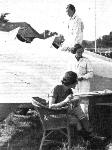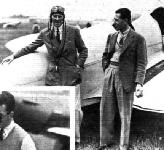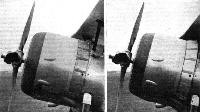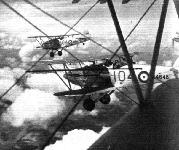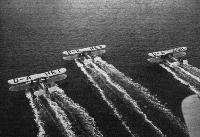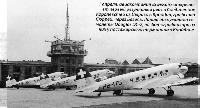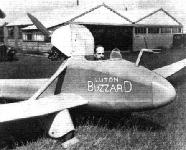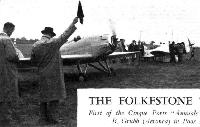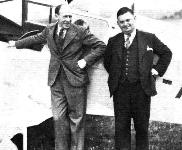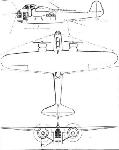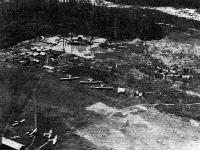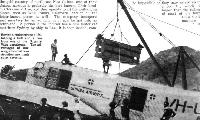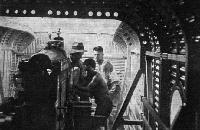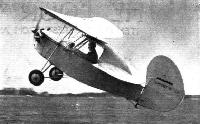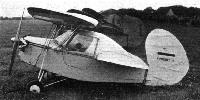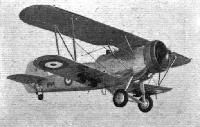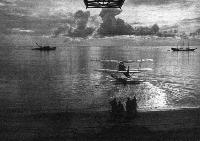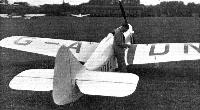Фотографии
-
Регистрационный номер: NC14988 FOR TRUNK ROUTES. Douglas DC-3 monoplanes have been ordered by American Airlines, United Airlines, K.L.M. and T.W.A. For night operation, when the machine is usually known as the D.S.T. (Douglas Sleeper Transport), sleeping accommodation for up to fourteen passengers is provided. By day there are seats for twenty-four. The new Wright Cyclone Model G or the Pratt and Whitney Twin Wasp engines are variously specified. With Cyclone G2s, which are supercharged to give 850 h.p. at 5,800 feet the maximum speed is 213 m.p.h. The cruising speed at 10,000 ft. is 180 m.p.h. Structurally the machine is similar to the well-established D.C.2. Externally it may be distinguished from that machine by forward continuation of the fin.
Самолёты на фотографии: Douglas DC-3 / C-47 Skytrain/С-53 Skytrooper / Dakota - США - 1935
-
The famous French pilot Detroyat with the new Morane Saulnier 405 fighter, which has the very latest Hispano Y canon engine.
Michel Detroyat is seen here after a display in one of the earlier Moranes with a Ratier "windmill-controlled" airscrew which permitted the use of the engine-mounted shell-gun. This design has now been superseded.Самолёты на фотографии: Morane-Saulnier MS.405/406/410C1 - Франция - 1935
-
THREE-PLACE, THREE-PURPOSE. The first photograph of the new three-seater Potez 63 monoplane planned for fighting, bombing and observation. Two 670 h.p. two-row Hispanos are fitted and are believed to give a maximum speed of the order of 300 m.p.h. Basically the machine may be regarded as being in the same category as our Bristol Blenheim now in production for R.A.F. squadrons. So far as is known no order for the Potez has yet been placed by France.
Самолёты на фотографии: Potez Potez 63 - Франция - 1936
-
Winner, second and co-third in the competition : In the cockpit of the Hawk Major is Miss Moore, while below can be seen Mrs. Fisher and Miss Hughes, who tied with Mrs. Macdonald for third place.
Самолёты на фотографии: Miles Hawk / M.2 - Великобритания - 1932
-
The ultimate winner is flagged off: Mr. George Reynolds and the Hawk Speed Six, flown by Mr. Humble.
Самолёты на фотографии: Miles Hawk / M.2 - Великобритания - 1932
-
The unlucky ones: Mr. J. M. Bickerton and Mr. E. F. Walter who finished first and second in the race, but were disqualified on a technical point at the Yeadon control.
Самолёты на фотографии: Miles Hawk / M.2 - Великобритания - 1932
-
PERFORMING MICE: An amusing snapshot from behind a Zwicky refuelling unit at Biggin Hill, with Bulldogs of No. 32 Squadron which took part in the Exercises.
Самолёты на фотографии: Bristol Bulldog - Великобритания - 1927
-
The new Bristol controllable cowling closed and open. The installation illustrated is on the Mercury engine of a Bulldog IV single-seater fighter used for experimental work.
Самолёты на фотографии: Bristol Bulldog - Великобритания - 1927
-
Four Seversky models gathered together at Farmingdale, Long Island, U.S.A., illustrate the persistence of the family likeness. From left to right are the new amphibian two-seater fighter (three of these have already been delivered to the Colombian Government); a landplane version of the machine on which Major de Seversky, its designer, established the world's amphibian speed record with 230.03 m.p.h.; the 1,000 h.p. Twin-Wasp-powered fighter ordered in quantity by the U.S. Army Air Corps; and the basic trainer for the same service.
Самолёты на фотографии: Seversky P-35 - США - 1936Seversky SEV-2XP / BT-8 - США - 1934Seversky SEV-3 - США - 1933
-
Регистрационный номер: G-ACWR Mr. Brie initiates the uninitiated with the C.30 Autogiro. A number of people made flights in this machine later in the afternoon. Three of the many visiting machines may be seen below.
Самолёты на фотографии: Cierva/Avro C.30A / Rota - Великобритания - 1932
-
THE GRASP OF STEEL: A Gloster Gauntlet of No. 111 (Fighter) Squadron about to take oft from Biggin Hill to intercept air-exercise raiders.
Самолёты на фотографии: Gloster Gauntlet - Великобритания - 1929
-
Регистрационный номер: K5265 ALERT: A fine study of Gauntlets of No. 111 (Fighter) Squadron at Biggin Hill being prepared to intercept a raid during last week's Air Exercises.
Самолёты на фотографии: Gloster Gauntlet - Великобритания - 1929
-
Регистрационный номер: K4648 OPERATIONAL HEIGHT. Hawker Hind light bombers are now well established as Service equipment. Their engines - Rolls-Royce Kestrel Vs, which give a maximum of 640 at 14,000 ft. - permit them to operate efficiently at high altitudes where they can attain speeds up to 200 m.p.h. This "shot," secured during the recent exercises, depicts Hinds of No. 104 Squadron. Note, incidentally, the new "kidney" type exhausts and the "cut-away" gunners cockpits as on the Demon two-seater fighter.
Самолёты на фотографии: Hawker Hind - Великобритания - 1934
-
Регистрационный номер: D-AGOR, D-AHET, D-ANES Another striking photograph from the German seaplane school.
Самолёты на фотографии: Heinkel He-59 - Германия - 1931
-
Seen on the trip: French Naval seaplane being refuelled at Duala, French Cameroons.
Самолёты на фотографии: Gourdou-Leseurre GL 832Hy - Франция - 1932
-
An enlightening view of the new Vought scout bomber with Pratt and Whitney Twin Wasp Junior engine and constant-speed airscrew.
Самолёты на фотографии: Vought SB2U Vindicator / V-156 - США - 1936
-
Keepers of the Pax Britannica: Vickers Valentias over the citadel of Cairo.
Самолёты на фотографии: Vickers Valentia - Великобритания - 1934
-
Регистрационный номер: HB-ITA, HB-ITE, HB-ITO 1 апреля 1935г.: авиакомпания "Swissair" открывает первый регулярный рейс в Соединенное Королевство из Цюриха в Кройдон, графство Сюррей, через Базель. Линию обслуживали самолеты Douglas DC-2, на фотографии три из
них у пассажирского терминала в Кройдоне.
THE HOLIDAY RUSH: An unusual sight at Croydon on a recent Saturday, when the Swissair Douglases carried a record amount of traffic between London and Switzerland.Самолёты на фотографии: Douglas DC-1 / DC-2 / C-32 / C-39 - США - 1933
-
Регистрационный номер: D-UNEN GERMANY'S BIGGEST: Two years ago the site of the new Frankfurt airport, opened on July 8th by General der Flieger Erhard Milch, was virgin forest. This photograph shows the terminal building and something of the scene at the opening ceremony, with a Heinkel He 70 in the foreground.
Самолёты на фотографии: Heinkel He-70/Не-170 Blitz - Германия - 1932
-
Регистрационный номер: G-ACSK, G-ACWB INSTRUCTIONAL FLEET: Now that the London Aeroplane Club have obtained their new D.H. Dragonfly for twin-engined training their instructional fleet is one of the most complete in the country. In this Flight photograph there will be seen the Dragonfly, two Hornet Moths and five of the six Tiger Moths. In the foreground (though not to be recognised) are Messrs. Rodwell, Harris, Goodyear and Maclaren, respectively secretary, chief instructor and assistant instructors.
Самолёты на фотографии: De Havilland Dragonfly / D.H.90 - Великобритания - 1935De Havilland Hornet Moth / D.H.87 - Великобритания - 1934De Havilland Tiger Moth / D.H.82 - Великобритания - 1931
-
A general view of the scene at the Eastbourne Club's "At Home" immediately prior to the prize-giving, with some of the club members and guests in the tea enclosure and the Monospar Ambulance on the left.
Самолёты на фотографии: General Aircraft Monospar ST-25 Universal - Великобритания - 1935
-
Регистрационный номер: G-ADYX [3] F/O. Stodart comes in to land with the Luton Buzzard. The split flaps can be seen in their fully down position.
Самолёты на фотографии: Luton Buzzard - Великобритания - 1936
-
Регистрационный номер: G-ADYX [3] The clean and handsome lines of the Buzzard are obvious in this view, which also shows that the fuselage is almost parallel from engine to tail.
Самолёты на фотографии: Luton Buzzard - Великобритания - 1936
-
Регистрационный номер: G-ADYX [3] The designer, Capt. C. H. Latimer-Needham, in the cockpit of the Buzzard. The machine can be flown comfortably without helmet or goggles.
Самолёты на фотографии: Luton Buzzard - Великобритания - 1936
-
OPENING UP AFRICA. Mr. K. W. Brett, who set off from Cairo last Sunday in the Shell company's Percival Gull (seen in the photograph) for a six weeks' tour of Africa. He is to carry out preliminary survey work for aircraft refuelling stations in various parts of Africa, including those on the probable track of the West African Imperial Airways service. In company with M. Vuillemin of the Shell Company in Algiers, he will also inspect sites for stations in the Sahara, Nigeria, and French Equatorial Africa.
Самолёты на фотографии: Percival Gull - Великобритания - 1932
-
Регистрационный номер: G-AAIG, G-AEKL Scratch and subscratch: Lord Patrick Crichton-Stuart (Hendy Hobo) awaits the fall of the flag in the final of the Folkestone Aero Trophy race, while Captain Percival prepares to start his Mew Gull, which had another ten minutes to wait.
Самолёты на фотографии: Hendy Hobo - Великобритания - 1929Percival Mew Gull - Великобритания - 1934
-
GROOMING AT GRAVESEND: Capt. Percival superintends the preparation of some of his products for the Schlesinger Johannesburg Race. In the foreground is the 225 m.p.h. Mew Gull to be flown by Capt. Miller, which is receiving a Ratier variable pitch airscrew
Самолёты на фотографии: Percival Mew Gull - Великобритания - 1934
-
In second place: Mr. S. W. Sparkes and his passenger with their Percival Vega Gull.
Самолёты на фотографии: Percival Vega Gull / K.1 - Великобритания - 1935
-
The German pilot Achgelis with the Focke-Wulf FW 56 in which he took second place in the Rangsdorf aerobatic competition
Самолёты на фотографии: Focke-Wulf FW.56 Stosser - Германия - 1933
-
The general arrangement of the Koolhoven F.K.50 B bomber.
Самолёты на фотографии: Koolhoven FK-50 - Нидерланды - 1935
-
HIGH-SPEED LUXURY: The latest Beechcraft photographed last Saturday at Lympne whither it was brought by Mr. James Haislip, the European representative. This machine, the C.17.R, is powered with a 420 h.p. Wright Whirlwind (which gives it a maximum speed of 210 m.p.h. at 12,000 feet) and was brought over, appropriately enough, by airship from the States. Surrey Flying Services are the Beech agents for the United Kingdom and Ireland.
Самолёты на фотографии: Beechcraft Model 17 Staggerwing - США - 1932
-
Sired by a racer: The new Howard four-seater (Whirlwind 320) developed from the indefatigable Mr. Mulligan.
Самолёты на фотографии: Howard DGA-6, -7, -8, -11, -12 - США - 1935
-
The gold rush: One of the mine landing grounds with the dredge in operation and most of the Guinea Airways' fleet deployed on the field.
Самолёты на фотографии: Junkers G 31 - Германия - 1926
-
Bovine airmindedness: Unloading a bull and a cow from one of the G.31S at Wau aerodrome. The advantages of low-wing all-metal construction are made quite obvious.
Самолёты на фотографии: Junkers G 31 - Германия - 1926
-
Half a ton or so: This photograph gives an idea of the method used for stowing freight in one of the G.A. Junkers it is actually being loaded at Lae for transport to the Bulolo goldfields. The size of the loading hatch is noteworthy.
Самолёты на фотографии: Junkers G 31 - Германия - 1926
-
The winner of the trophy, Mr. R. Grubb, beside the urge-provider of his Aeronca,
Самолёты на фотографии: Aeronca C - США - 1929
-
Регистрационный номер: D-APIS DIESEL GIANT: The Junkers G.38, with four Jumo IV diesel engines, gets her tail up for a tarmac take-off at Croydon.
Самолёты на фотографии: Junkers G 38 - Германия - 1929
-
An interesting visitor to Croydon early this week was the huge Junkers G.38, shown in front view.
Самолёты на фотографии: Junkers G 38 - Германия - 1929
-
A panel-type Vokes air filter as applied to a Cheetah IX installation on a convertible Airspeed Envoy for South Africa.
Самолёты на фотографии: Airspeed Envoy / AS.6 - Великобритания - 1934
-
Регистрационный номер: G-AEJD In Fig. 1, on the left, the tufts show that most of the port half of the front wing was stalled, due probably to a certain amount of sideslip. The bending inward of the flow at the trailing edge near the tips is seen in Fig. 2, right.
Самолёты на фотографии: Mignet Pou-de-Ciel / HM-14 - Франция - 1932
-
M. Bret, the winner; he used a 4-cyI. Ava two-stroke.
Самолёты на фотографии: Mignet Pou-de-Ciel / HM-14 - Франция - 1932
-
Регистрационный номер: G-AEFV A Pou on test in the large wind tunnel at Farnborough.
Самолёты на фотографии: Mignet Pou-de-Ciel / HM-14 - Франция - 1932
-
CORPULENT WARRIOR. This close-up of the nasal arrangements of a Grumman SF-1 scout of the U.S. Navy shows the retractable undercarriage and the landing light in the fuselage.
Самолёты на фотографии: Grumman FF / SF / Goblin - США - 1931
-
Lowdell low down: Mr. George Lowdell, who put up two masterly aerobatic displays, and his Hawker Tomtit in the act of strafing the clubhouse.
Самолёты на фотографии: Hawker Tomtit - Великобритания - 1928
-
M. Mignet smiles at Flights photographer as the H.M.18 leaps into the air.
Самолёты на фотографии: Mignet HM-18 / HM-19 / HM-210 / HM-360 / HM-380 - Франция - 1936
-
Mignet's latest. The H.M.18 will probably be the French factory-built version of the Pou. Note that the wings do not overlap, and that the front wing is placed much higher than in the original Pou.
Самолёты на фотографии: Mignet HM-18 / HM-19 / HM-210 / HM-360 / HM-380 - Франция - 1936
-
The H.M.18 is a cabin single-seater with Mengin engine. It takes off in a very short run and has an excellent climb.
Самолёты на фотографии: Mignet HM-18 / HM-19 / HM-210 / HM-360 / HM-380 - Франция - 1936
-
Historical interlude at the Tempelhof display - the Grade monoplane of circa 1910
Самолёты на фотографии: Grade monoplane - Германия - 1909
-
Seen on the trip: Refuelling a trimotor Bloch of Air Afrique at Zinder (French Niger Colony)
Самолёты на фотографии: Bloch MB.60 / MB.120 - Франция - 1930
-
Регистрационный номер: X266Y [2] The sporting lines of the new Brown B-3 monoplane are seen to advantage here.
Самолёты на фотографии: Brown Racer / B-1 / B-2 - США - 1932
-
Регистрационный номер: X266Y [2] "Close ups" of a Handley Page slot and the flap and aileron arrangements on the new Brown monoplane.
Самолёты на фотографии: Brown Racer / B-1 / B-2 - США - 1932
-
Регистрационный номер: NR71Y American racing type, familiar to visitors to the American National Air Races: Gilmore;
Самолёты на фотографии: Brown Racer / B-1 / B-2 - США - 1932
-
A high-altitude test flight with full military load by Mr. P. W. S. Bulman on the Hawker P.V.4 general-purpose dive bomber biplane.
Самолёты на фотографии: Hawker PV.4 - Великобритания - 1934
-
The general layout of the Hawker P.V.4 may be gathered from this view. The resemblance to previous Hawker two-seaters is pronounced.
Самолёты на фотографии: Hawker PV.4 - Великобритания - 1934
-
Dawn over the North Sea: a fine impression from a German seaplane training school - the identity of which, incidentally, is wrapped in mystery.
Самолёты на фотографии: Heinkel He-42 - Германия - 1931
-
A new lightweight, made by Bock of Hamburg and fitted with a 20 h.p. Ilo engine, seen at the Tempelhof meeting
Самолёты на фотографии: Bock aircraft - Германия - 1936
-
American racing type, familiar to visitors to the American National Air Races: Gordon Israels;
Самолёты на фотографии: Israel Redhead - США - 1932
-
Регистрационный номер: R500W American racing type, familiar to visitors to the American National Air Races: Wittman (???);
Самолёты на фотографии: Folkerts SK-1 - США - 1933
-
American racing type, familiar to visitors to the American National Air Races: Heath;
Самолёты на фотографии: Heath CNA-40 Center-Wing - США - 1932
-
Регистрационный номер: NR55Y American racing type, familiar to visitors to the American National Air Races: Howard;
Самолёты на фотографии: Howard DGA-4 - США - 1932
-
Регистрационный номер: R52Y American racing type, familiar to visitors to the American National Air Races: Keith Rider;
Самолёты на фотографии: Rider R-1 / R-2 / R-4 / R-5 / R-6 - США - 1931
-
American racing type, familiar to visitors to the American National Air Races: Miles and Attwood;
Самолёты на фотографии: Miles & Atwood Special - США - 1933
-
American racing type, familiar to visitors to the American National Air Races: Nicholas Beazley.
Самолёты на фотографии: Nicholas Beazley Pobjoy Special - США - 1930
-
Регистрационный номер: G-ADNL [2] Homage to E. F. Walter's Hawk and F/O A. E. Clouston's Sparrow Hawk (scratch) at the start of the Contact race.
Самолёты на фотографии: Miles Sparrowhawk / M.5 - Великобритания - 1935
-
Регистрационный номер: G-ADNL [2] F/O. A. E Clouston clears up a matter of regulations before the start with the support of his Miles Sparrow Hawk, which incidentally, put up fastest time.
Самолёты на фотографии: Miles Sparrowhawk / M.5 - Великобритания - 1935
Статьи
- Flight
- Flight Advertisements



